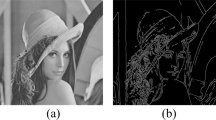Abstract
In recent years many methods for image watermarking have been proposed to overcome the growing concern of copyright protection. The goal of all these methods is to satisfy the tradeoff between two important characteristics of robustness and imperceptibility. In this paper an adaptive blind watermarking method in the Contourlet transform domain is proposed. In this method we apply a two-level Contourlet transform on the original image. The first level approximate image is partitioned into blocks. Using a novel edge detection algorithm, important edges of each block of the approximate image are detected and the entropy of each block is also computed. Then by concatenating some portions of the second level subbands we form blocks. These formed blocks are transformed into DCT domain. Watermark is embedded by modification of the DCT coefficients. The severity of the embedding is controlled depending on the complexity of the corresponding block in the approximate image. For higher robustness against attacks, we embedded the watermark redundantly and used voting mechanism in extraction stage. Experimental results reveal that our method has high robustness and acceptable imperceptibility.






Similar content being viewed by others
References
Akhaee MA, Sahraeian SME, Marvasti F (2010) Contourlet-based image watermarking using optimum detector in a noisy environment. IEEE Trans Image Process 19(4):967–980
Azizi S, Samavi S, Mohrekesh M, Shirani S (2013) Cascaded transform space watermarking based on analysis of local entropy variation. IEEE International Conference on Multimedia and Expo Workshops (ICMEW), 1–6
Cox, Ingemar J, Matthew LM, Jeffrey AB, Honsinger C (2002) Digital watermarking. 53
Ghannam S, Abou-Chadi FE (2009) Enhancing robustness of digital image watermarks using Contourlet transform. 16th IEEE International Conference on In Image Processing (ICIP), 3645–3648
Gonzalez RC, Woods RE (2002) Digital image processing
Hernández-Vela A, Gatta C, Escalera S, Igual L, Martin-Yuste V, Sabaté M, Radeva P (2012) Accurate coronary centerline extraction, caliber estimation, and catheter detection in angiographies. IEEE Trans Inf Technol Biomed 16(6):1332–1340
Horng SJ, Rosiyadi D, Fan P, Wang X, Khan MK (2014) An adaptive watermarking scheme for e-government document images. Multimedia Tool Appl 72(3):3085–3103
Horng SJ, Rosiyadi D, Tianrui L, Takao T, Guo M, Khan MK (2013) A blind image copyright protection scheme for e-government. J Vis Commun Image Represent 24(7):1099–1105
Kaviani HR, Karimi N, Samavi S (2011) Robust watermarking in singular values of contourlet coefficients. Machine Vision and Image Processing (MVIP), 1–5
Kaviani HR, Samavi S, Karimi N, Shirani S (2012) Elevating watermark robustness by data diffusion in Contourlet coefficients. IEEE International Conference on Communications (ICC), 6739–6743
Lai CC, Tsai CC (2010) Digital image watermarking using discrete wavelet transform and singular value decomposition. IEEE Trans Instrum Meas 59(11):3060–3063
Lin WH, Horng SJ, Kao TW, Chen RJ, Chen YH, Lee CL, Terano T (2009) Image copyright protection with forward error correction. Expert Syst Appl 36(9):11888–11894
Lin WH, Horng SJ, Kao TW, Fan P, Lee CL, Pan Y (2008) An efficient watermarking method based on significant difference of wavelet coefficient quantization. IEEE Trans Multimedia 10(5):746–757
Lin WH, Wang YR, Horng SJ, Kao TW, Pan Y (2009) A blind watermarking method using maximum wavelet coefficient quantization. Expert Syst Appl 36(9):11509–11516
Lin WH, Wang YR, Horng SJ (2009) A wavelet-tree-based watermarking method using distance vector of binary cluster. Expert Syst Appl 36(6):9869–9878
Meerwald P, Andreas U (2001) Survey of wavelet-domain watermarking algorithms. International Society for Optics and Photonics 505–516
Potdar, Vidyasagar M, Song H, Chang E (2005) A survey of digital image watermarking techniques. 3rd IEEE International Conference on In Industrial Informatics, 709–716
Rosiyadi D, Horng SJ, Fan P, Wang X, Khan MK, Pan Y (2012) Copyright protection for e-government document images. MultiMedia, IEEE 19(3):62–73
Solachidis V, Ioannis P (2001) Circularly symmetric watermark embedding in 2-D DFT domain. IEEE Trans Image Process 10(11):1741–1753
Suhail MA, Obaidat MS (2003) Digital watermarking-based DCT and JPEG model. IEEE Trans Instrum Meas 52(5):1640–1647
Taherinia AH, Jamzad M (2009) A robust spread spectrum watermarking method using two levels DCT. Int J Electron Secur Digit Forensics 2(3):280–305
Wang Y, Doherty JF, Van Dyck RE (2002) A wavelet-based watermarking algorithm for ownership verification of digital images. IEEE Trans Image Process 11(2):77–88
Xinbo G, Deng C, Li X, Tao D (2010) Geometric distortion insensitive image watermarking in affine covariant regions. IEEE Trans Syst Man Cybern 40(3):278–286
Zhang H, Shu H, Coatrieux G, Zhu J, Wu QJ, Zhang Y, Zhu H, Luo L (2011) Affine Legendre moment invariants for image watermarking robust to geometric distortions. IEEE Trans Image Process 20(8):2189–2199
Zong T, Xiang Y, Natgunanathan I, Guo S, Zhou W, Beliakov G (2014) Robust histogram shape based method for image watermarking. IEEE Trans Circut and Syst for Video Tech 25(5):717–729
Author information
Authors and Affiliations
Corresponding author
Rights and permissions
About this article
Cite this article
Fazlali, H.R., Samavi, S., Karimi, N. et al. Adaptive blind image watermarking using edge pixel concentration. Multimed Tools Appl 76, 3105–3120 (2017). https://doi.org/10.1007/s11042-015-3200-6
Received:
Revised:
Accepted:
Published:
Issue Date:
DOI: https://doi.org/10.1007/s11042-015-3200-6




